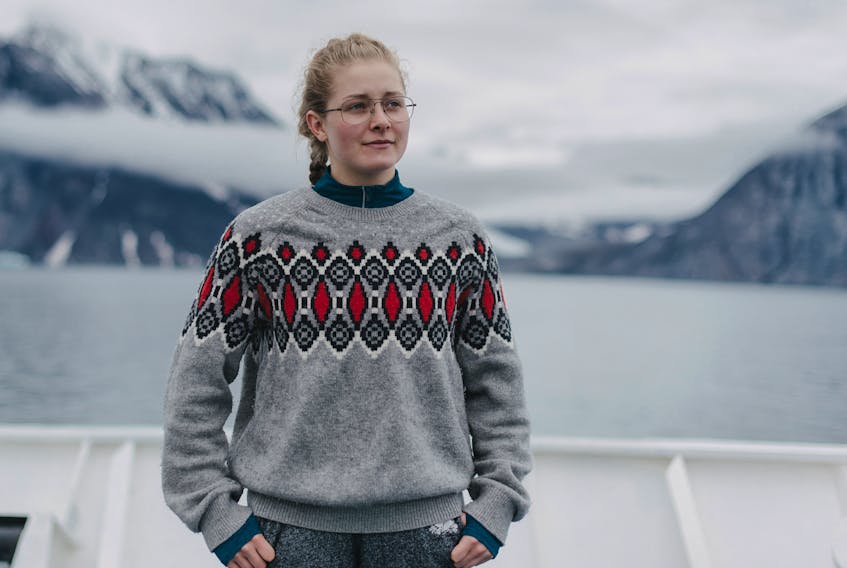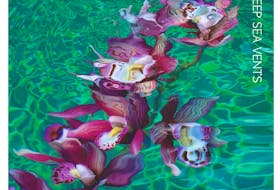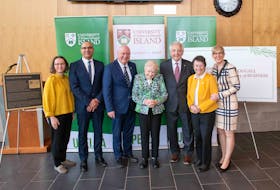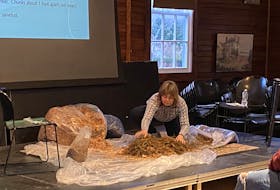
Learning how they can make a difference in the future of our planet was one of several focusses presented to participants in the 2018 Students on Ice (SOI) Arctic expedition.
The expedition was recently completed and featured a total of nine participants from Newfoundland and Labrador, all seeking to make changes to the way we view our planet and the impact we are having on the Polar region.
Adena Peters and Polina Konstantinova were two of those youth.
Peters is a recent graduate from the University of New Brunswick at Saint John where she earned a Bachelor of Science degree in marine biology. She is extending that education through the marine environmental technology program at the Marine Institute of Memorial University in St. John’s.
“I have a passion for the marine environment and love to learn in every aspect of my life. I also enjoy travelling and see new places and meeting new people,’’ she said on the Students on Ice webpage.
“When I’m not studying or working, I enjoy volunteering with science outreach programs and engaging others in science and conservation,’’ she added.
Konstantinova is also from St. John’s, and she spends her spare time as a competitive swimmer, musician and air cadet, in addition to being a recreational kayaker and cyclist. She is a grade 12 student at St. Bonaventure's College in St. John's.
Joining the Newfoundland and Labrador contingent on the journey were: Brady Reid (Corner Brook), Trevor Dicker (Nain), Sydney Dicker (Nain), Denver Edmunds (Hopedale), Danika Mitchell (Makkovik), Petshish Jack (Sheshatshiu) and Ocean Pottle-Shiwak (Rigolet).
“After doing this expedition, I have a different perspective on climate change and the Arctic,’’ Konstantinova said.
She thanked the United States embassy in Ottawa for helping make this adventure happen for her as they sponsored her trip. All she had to do was pay for airfare to get back and forth, otherwise she said she wouldn’t have been able to go.
“I was shocked how much Greenland looked like Newfoundland. The valley and the mountains looked like Gros Morne to the left and Quidi Vidi Village on the right,’’ she said.
“Behind the harbour and the houses were giant ice bergs. It made me feel like I was home.”
She said there was “the most beautiful soccer field in the world” there which was next to the beach in Qeqertarsuaq. Standing looking out at the pitch, its back drop were the icebergs, the biggest she had ever seen, calling the ones that make it to Newfoundland miniature in compariso.
Konstantinova said taking part in the events and concerts in each of the stops on the expedition allowed the group to enhance their global cultural knowledge.
A group travelling with them — Twin Flames — performed at one of the stops in Pond Inlet. This performance also included local residents of the community to be involved in the cultural performances, throat singing, games etc.
“All this just shows how small we are in the world … and how huge a difference we can make,’’ she said.
The expedition explored the communities, coasts and fjords of western Greenland before crossing the Davis Strait to Canada’s High Arctic and the Northwest Passage.
Activities included the collection of eDNA samples from the Arctic coastline to learn about the changing biodiversity of the area; exploring the land and gaining cultural and historical knowledge from Inuit Elders, scientists, archaeologists, and community members; hikes across tundra; observing wildlife; working with climate scientists to understand the drastic changes being seen in the Polar regions and their impacts; and learning first-hand about important Arctic marine ecosystems such as Pikialasorsuaq (the North Water Polyna) and Tallurutiup Imanga (Lancaster Sound).
“I really enjoyed it. You would be hard-pressed to find anyone in our group that didn’t,” Peters said.
“It was a wonderful experience, a once in a lifetime adventure. I learned a lot about the Arctic environment, learned about Canadian history and the people of the North,” she added.
Related story:
Peters said she is leaning towards a future in conservation or the environment based on this experience and her studies.
“I think I will follow on the path of conservation,” she said noting she is employed with the Department of Fisheries and Oceans this summer a work term studying this province’s salmon.
She said she has always had an interest in the polar regions and is interested in the Arctic and Antarctic. The expedition also have her perspective in climate change.
“I got to see it first hand, what is happening .. and the people who are living with it on a daily basis.”
The expedition took place from July 23-Aug. 7 where 130 students and more than 80 staff from 20 countries participated. They explored the communities and coasts of the west coast of Greenland and crossed the Davis Strait in addition to sailing through the entrance to the Northwest Passage.
This year’s education pillars were centered on climate change adaptation, ocean literacy, sustainable development goals and truth and reconciliation.
The team participated in Zodiac excursions around icebergs, glaciers and bird colonies; hikes across tundra; visits to remote Arctic communities; engaged in citizen science to better understand the health of the coastal environment; learned from Inuit leaders about history, politics, culture and the social and environmental challenges they face; and connected with a diversity of students and educators from around the world!
Of the 130 students on board, nearly 40 per cent were Indigenous from Canada, Greenland and Alaska and a majority of student participants (80 per cent) were fully funded thanks to SOI’s global network of partnerships.
The diversity of students is integral to SOI’s mandate — fostering a global perspective — and understanding of the challenges and opportunities society is facing.
The result of SOI’s 18 years of expeditions is more than 2,700 alumni from 52 countries who — fueled by their connection to the land and people of the Arctic — are making a difference in their communities and countries.
“There were two communities in Greenland we visited that were amazing. We were supposed to go to another place, but the ice was too bad for us, so we went to another community (Qeqertarsuaq),” Peters said.
“It had such a good vibe. I got to see a black beach for the first time and we got to watch a soccer game that was going on. The energy was amazing,” she added.
To learn more and to follow the journey, visit studentsonice.com .









